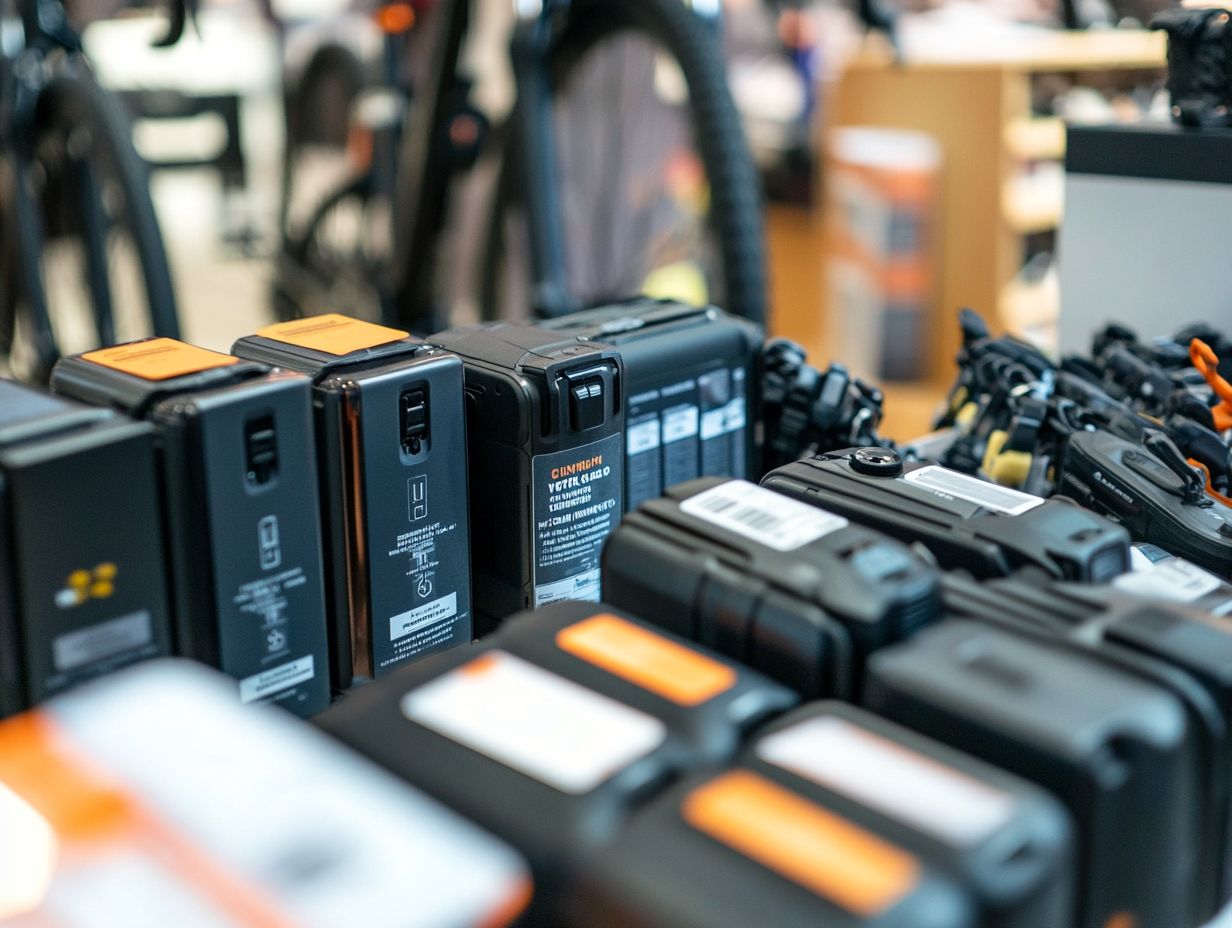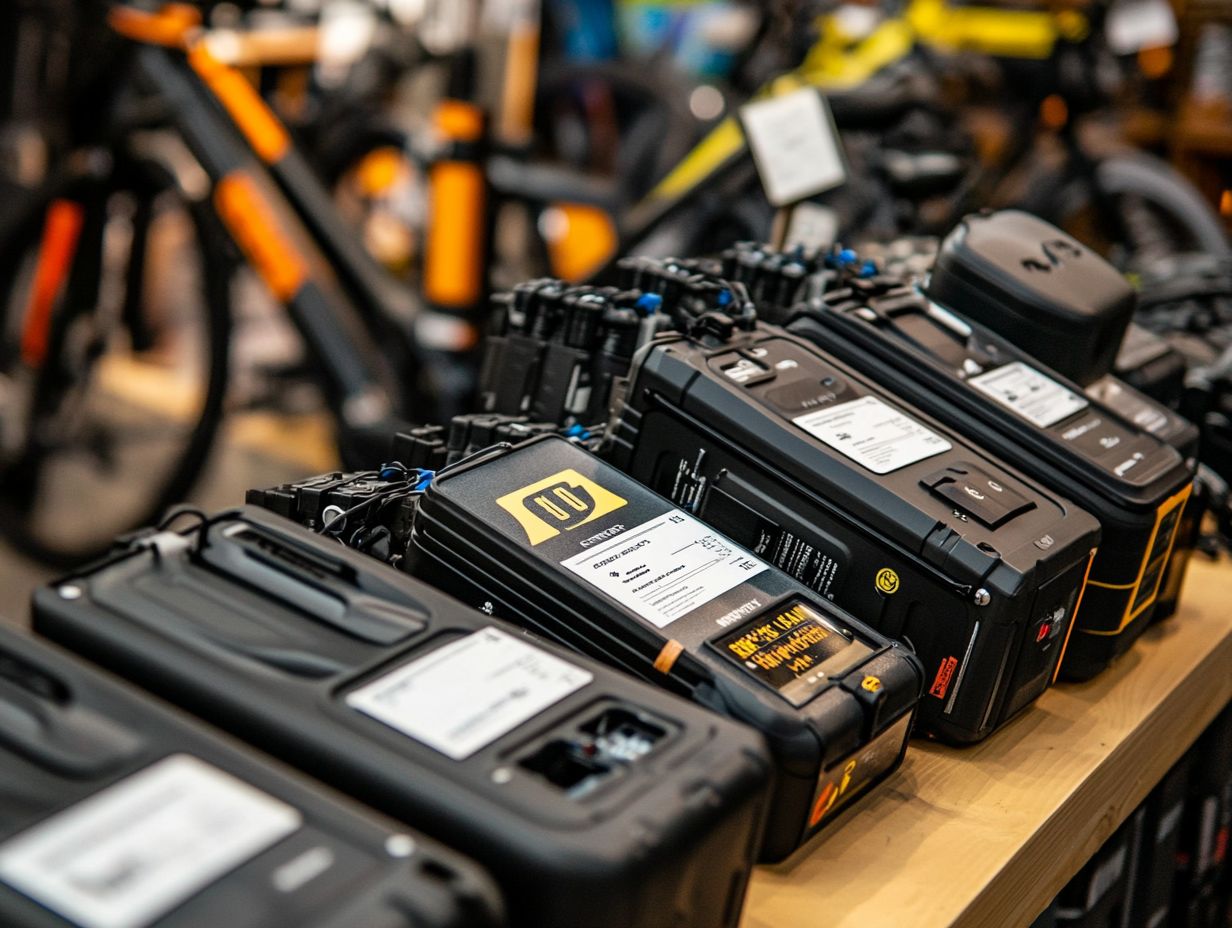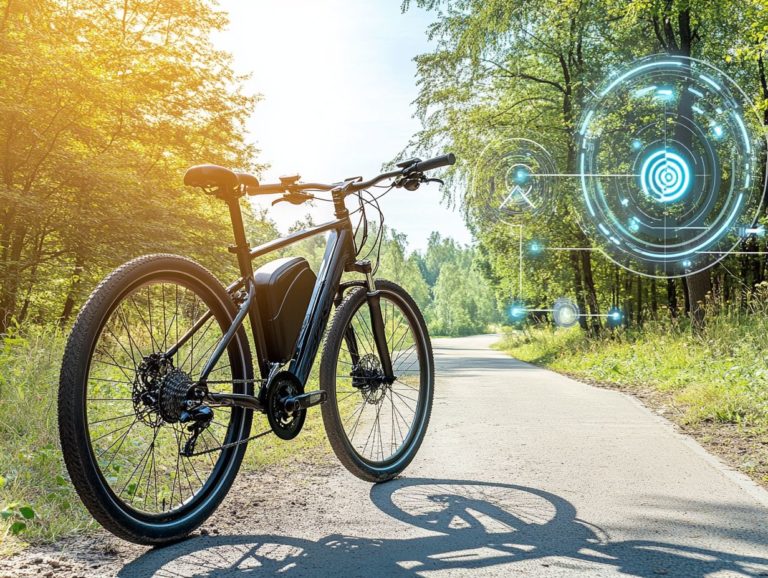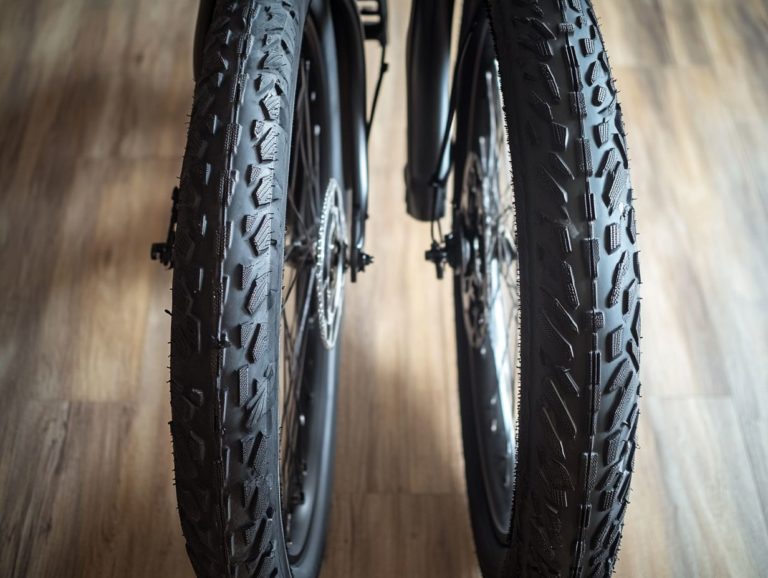What Types of Batteries are Used in E-Bikes?
E-bike batteries are the heart of electric bicycles, powering your rides and significantly affecting how well your bike performs.
With a range of options available, including lead-acid, lithium-ion, and nickel-metal hydride batteries, each type has unique benefits and drawbacks. Get to know your options to supercharge your rides!
Consider factors such as battery capacity, lifespan, charging time, and cost; these all play pivotal roles in shaping your cycling experience.
Proper maintenance extends your battery’s life. Delve into the details and discover everything you need to elevate your e-bike journey!
Contents
Key Takeaways:

- Lithium-ion batteries are a top choice for e-bikes because they last longer and pack more power.
- Consider battery capacity and charging time to maximize performance and value.
- Regular maintenance and proper charging habits can help extend your e-bike battery’s lifespan, but it’s crucial to replace it when it no longer holds a charge or shows signs of deterioration.
What are E-Bike Batteries?
E-bike batteries are essential components of electric bikes, powering the motor and providing that extra boost during your rides. These batteries come in various types, each with unique characteristics that influence performance, longevity, and environmental impact.
Selecting the right battery type is crucial because it directly affects your bike’s range and efficiency. Beyond the popular lithium-ion batteries, you also have alternatives like nickel-metal hydride (NiMH) and lead-acid batteries, each with their benefits and drawbacks.
While NiMH batteries are prized for their durability and safety, lead-acid batteries tend to be more budget-friendly but are heavier and have a shorter lifespan.
Effective battery management systems are key to maintaining optimal performance by balancing charge cycles and preventing overheating. By understanding the different battery options and their functionalities, you can elevate your biking experience while making informed choices that positively impact environmental sustainability through wise battery usage and maintenance.
Types of Batteries Used in E-Bikes
The types of batteries used in electric bikes are diverse, each bringing its own benefits and drawbacks. Understanding these battery types is crucial, as they directly influence the performance, weight, cost, and longevity of your e-bike.
Among the most commonly used are lithium-ion batteries, which are highly favored for their impressive energy storage in a small size and extended life cycles. Meanwhile, lead-acid and nickel-metal hydride batteries might not offer the same efficiency but can be more budget-friendly.
Keep an eye on emerging technologies like solid-state batteries; they hold the potential for significant advancements in e-bike battery performance that could enhance your riding experience.
Lead-Acid Batteries
Lead-acid batteries have long been a go-to choice for electric bikes, largely due to their lower cost and well-established technology. While the price might seem appealing, consider their weight and environmental impact, especially compared to more advanced battery options.
Despite having lower energy storage and shorter lifespans, lead-acid batteries can still be a dependable choice for those on a budget looking to power their electric bikes.
Their relatively low upfront costs may draw you in if you’re prioritizing price over performance. However, their considerable weight can influence the overall handling of your bike. Additionally, lead-acid batteries generally last shorter than lithium-ion alternatives, which could lead to unexpected long-term costs from replacements.
It’s also imperative to consider the environmental implications since the toxic components involved in their production and recycling pose significant concerns. Balancing these factors is vital for making a well-informed decision when selecting the right battery for your electric biking needs.
Explore your e-bike options today and choose a battery that aligns with your cycling goals!
Lithium-Ion Batteries
Lithium-ion batteries have emerged as the gold standard for e-bike power, thanks to their remarkable energy density and impressive longevity. When you choose these batteries, you’re opting for superior performance in charge cycles the number of times a battery can be charged and used which maximizes your electric bike’s capabilities while minimizing its environmental footprint. However, this is provided they re managed correctly. With technology constantly evolving, Lithium-ion batteries continue to be the preferred choice for those who value efficiency and reliability in their e-bike experience.
Their lightweight design not only improves handling but also elevates your overall riding enjoyment. Don t forget to consider some drawbacks, such as the environmental impact of lithium mining and the challenges associated with recycling used batteries. Proper disposal and recycling are crucial to addressing these concerns.
While these batteries boast excellent longevity, their performance can deteriorate over time without proper maintenance. Therefore, finding a balance between innovation and sustainability is essential as manufacturers strive to develop solutions that tackle these challenges. This ensures that Lithium-ion batteries remain a viable option for eco-conscious riders like you, especially as solid-state batteries and Lithium-iron-phosphate batteries emerge in the market.
Nickel-Metal Hydride Batteries

Nickel-metal hydride batteries present a compelling alternative for e-bike power, offering a balanced energy density along with a host of advantages. You ll find these batteries are generally safer and more environmentally friendly compared to lead-acid options. However, they may not quite match the voltage and charging efficiency of their lithium-ion counterparts.
By mastering the art of properly charging and managing Nickel-metal hydride batteries, you can significantly boost their performance and longevity in your electric bike.
One of the standout features of these batteries is their remarkable ability to handle heavy discharge and recharge cycles, making them ideal for high-demand applications like e-bikes. With a lower self-discharge rate the rate at which a battery loses charge when not in use you can store your bike for extended periods without worrying about a major loss of charge. Understanding the charging schedule is key to maximizing performance.
However, it s essential to handle them with care; improper charging may lead to diminished lifespan or performance issues. While they can tolerate temperature fluctuations better than some alternatives, maintaining an optimal operating temperature is still crucial for enhancing their functionality and overall efficiency. This ensures your electric bicycle continues to run smoothly and reliably.
Factors to Consider When Choosing an E-Bike Battery
When you re choosing an e-bike battery, there are several important factors to consider for optimal performance and longevity. Key elements like battery capacity, cost, and charging time play a significant role in the efficiency and usability of your electric bike, including power requirements and various e-bike specifications.
It s also essential to grasp the safety concerns linked to various battery types, such as Lithium-ion and Lead-acid, as well as considerations for Lithium-polymer and solid-state batteries. This understanding helps you make a well-informed decision. Striking the right balance among these factors is vital for ensuring both performance and peace of mind as you ride.
- Battery capacity
- Cost
- Charging time
- Safety concerns
Make informed choices to enhance your e-bike experience!
Battery Capacity
Battery capacity is vital for your e-bike. It directly influences how far you can travel on a single charge. Measured in ampere-hours (Ah), a higher capacity generally means longer rides before recharging.
Lithium-ion batteries are celebrated for their impressive capacity, making them the go-to choice for serious cyclists aiming for extended journeys.
A higher capacity not only allows for longer distances but also boosts speed and acceleration, making steep climbs and rough terrains more manageable. When investing in an e-bike, consider the battery specifications carefully to meet your cycling needs while balancing capacity with the efficiency and enjoyment of your ride.
Battery Life
The battery life of e-bike batteries is crucial for rider satisfaction. It reflects how many charging cycles the battery can endure before it weakens. Generally, lithium-ion batteries provide superior longevity compared to other types, allowing you to enjoy your electric bike experience without frequent replacements.
Several factors can affect battery longevity, including environmental conditions, your usage habits, and how well you maintain the battery. Extreme temperatures both hot and cold can impact performance and charging efficiency, shortening the lifespan. Consistently depleting the battery before recharging may cause unnecessary strain, leading to premature degradation.
By following recommended care practices, such as avoiding deep discharges and keeping the charge level steady, you can enhance both the efficiency and lifespan of your battery. Regularly monitoring the battery s health and performing timely maintenance will further ensure optimal functionality, allowing you to enjoy your journeys with minimal interruptions.
Charging Time
Charging time is a key factor for e-bike batteries. It determines how quickly you can ride again after depleting your battery. Lithium-ion batteries generally charge faster than lead-acid or NiMH batteries, making them a more convenient choice for daily rides.
Several elements can affect charging times, including the battery’s capacity, the type of charger used, and the ambient temperature. Using a high-quality charger specifically designed for your battery type can considerably shorten the charging duration. Remember that cold temperatures can slow down the charging process, so charge your battery indoors whenever possible.
If you have lead-acid batteries, charging them more frequently can be beneficial, as they tend to take longer to reach a full charge. By adopting these strategies, you can ensure that your e-bike batteries remain in optimal condition and are always ready for your next adventure.
Cost

Cost is an important factor when selecting e-bike batteries, and it can vary significantly depending on the battery type and its specifications. While Lead-acid batteries may seem like a budget-friendly choice upfront, Lithium-ion batteries usually offer superior long-term value due to their exceptional performance and longevity.
Make sure you compare costs to find the best deal, weighing the cost against the expected lifespan and usability to ensure you re making a savvy investment.
Understanding the differences in initial costs can help clarify why many people prefer Lithium-ion batteries, despite their higher price tag. Although Lead-acid batteries might save you some cash at the outset, their shorter lifespan often leads to frequent replacements, ultimately inflating your long-term expenses.
Performance metrics like charging time and energy efficiency are vital for user satisfaction and are closely tied to overall costs. Therefore, analyzing these aspects not only aids in grasping the immediate financial commitment but also provides valuable insights that can lead to more informed decisions in the future.
Maintaining and Replacing E-Bike Batteries
Proper maintenance and timely replacement of e-bike batteries are essential for ensuring optimal performance and longevity. By adopting regular battery care practices such as utilizing appropriate charging systems and keeping an eye out for signs of degradation you can significantly prolong the life of your electric bike batteries.
Knowing when to replace an e-bike battery not only saves you time and money, especially when considering Lithium Iron Phosphate batteries, but also enhances your overall riding experience.
Tips for Extending Battery Life
To extend the battery life of your e-bike, there are several practical tips you can employ, especially for Lithium-ion batteries that require specific care. By establishing a consistent charging schedule, avoiding deep discharges, and storing the battery at suitable temperatures, you can notably enhance its longevity.
These straightforward practices can significantly improve both the performance and lifespan of your electric bike batteries.
It’s essential to steer clear of leaving the battery in extreme temperatures, whether hot or cold, as this can diminish its capacity over time. Regularly checking the battery’s health and performance allows you to catch any potential issues early on.
If your e-bike is going to sit idle for an extended period, consider partially charging the battery ideally up to around 50% to help maintain its condition.
Keeping the battery clean and free from dirt and corrosion is another effective way to ensure optimal performance, allowing your e-bike to operate smoothly while maximizing battery life.
When to Replace Your E-Bike Battery
Understanding when to replace your e-bike battery is crucial for maintaining peak performance and ensuring your safety on the road.
It’s wise to regularly monitor the battery’s condition; if you notice a decrease in range or find yourself recharging more often, it’s likely a sign that something is amiss. Pay attention to any unusual sounds or smells coming from the battery compartment these can be serious indicators of malfunction that you shouldn’t ignore.
Prioritizing battery health not only boosts your e-bike’s performance but also protects you from potential hazards, like battery leaks or even fires from Lithium-ion batteries.
By following proper maintenance routines and sticking to the manufacturer s guidelines, you can significantly reduce risks, allowing you to ride with confidence across a variety of terrains.
Frequently Asked Questions
What types of batteries are used in E-bikes?

There are several types of batteries used in e-bikes, including lithium-ion, lithium polymer, nickel-cadmium, and lead-acid batteries.
Which battery type is most commonly used in E-bikes?
Lithium-ion batteries are the most commonly used type in E-bikes because they have a high capacity for energy storage relative to their size, a long lifespan, and a lightweight design.
What are the advantages of using a lithium-ion battery in an E-bike?
Lithium-ion batteries also offer high energy efficiency and fast charging times. Plus, they have low self-discharge rates, making them perfect for E-bikes.
Can I use any type of battery in my E-bike?
No, you must use a battery specifically designed for E-bikes. These batteries have different charging and discharge rates compared to other types, ensuring optimal performance.
How long can I ride my E-bike on one battery charge?
Wondering how far you can ride? An E-bike can travel between 20-50 miles on a single charge, depending on factors like battery capacity, terrain, and rider weight.
Do I need to replace my E-bike battery?
Yes, all batteries will eventually need to be replaced. The lifespan of an E-bike battery depends on usage and proper care, but typically, it lasts between 2-5 years.
Ready to explore more about E-bikes? Learn about their benefits and consider making one your next purchase!
In summary, lithium-ion batteries are the ideal choice for E-bikes due to their efficiency, lightweight design, and longevity. Dive deeper into the world of E-bikes and discover how they can fit into your lifestyle!






